Camping Gear for Families with Babies and Toddlers
I became a convert to camping “later” in my life — around my late-20s, actually. Before then, the prospect of sleeping outside, without ready access to a good shower, food, or comfy bed struck me as, frankly, preposterous. Plus — the bugs. I HATE bugs. Ick.
Camping, I thought, was something other people did.
But then I lost a bet, went car camping for a weekend with my husband, and… loved it. It turns out that I think sleeping outdoors in a tent is unbelievably refreshing — not to mention the campfire and the delicious food and adult beverages we brought with us to top off the whole experience.
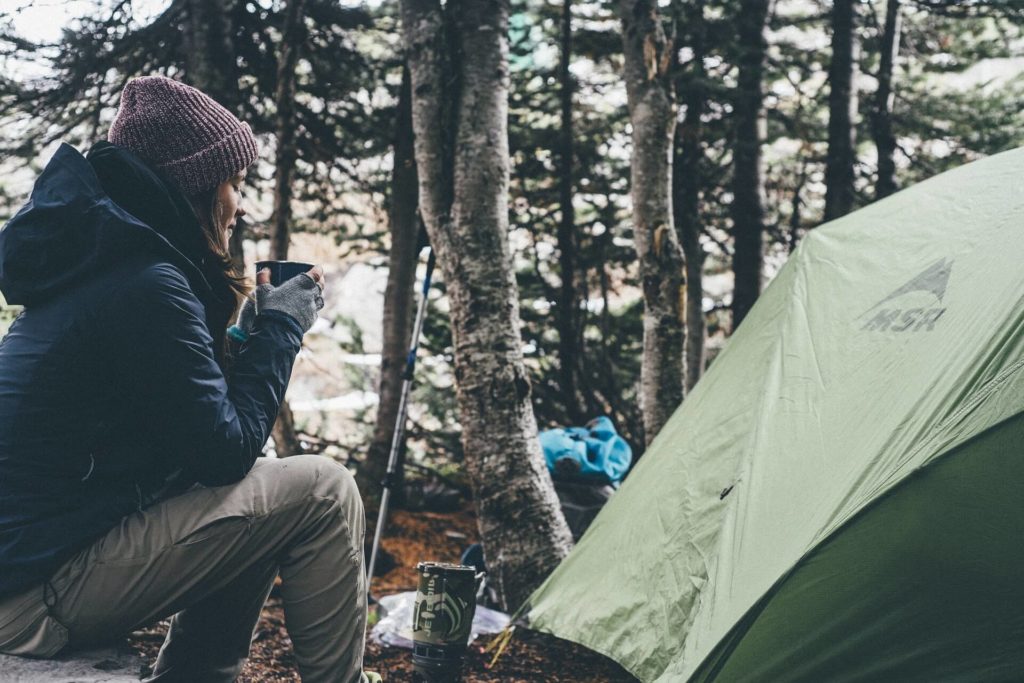
But I think what actually made all the difference for me was that my husband came PREPARED. He, to his credit, anticipated my every complaint and neutralized each one by having all the right “stuff” — we had a top-notch tent, sleeping bags warm enough for the Arctic, pads and extra blankets, camp chairs, lighting, even “camp slippers” with treading on the bottom (yes, they were just Uggs knock-offs).
Point being: the right tent camping gear can make or break it, for real. (Also, bad weather.)
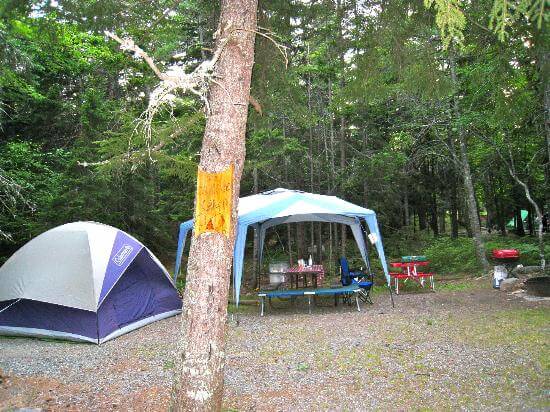
With kids, this is all the more true.
Much like a beach day with kids, family camping trips with kids are altogether different than adults-only camping.
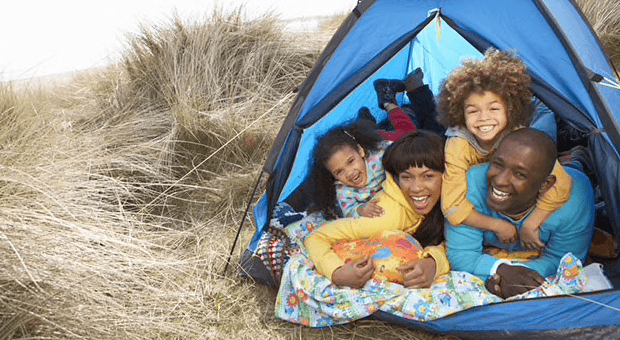
When our team debated covering family camping gear, we joked that the world is divided into “campers” and “no-effing-way-ers” (we’re guessing that since you’re here, chances are you’re the former). We also agreed that trying to talk anyone in the latter group into going camping with kids would be a lost cause.
That said — think about it! Once you’ve made the upfront investment in gear, camping is such an affordable way to travel.
If you’re overwhelmed at the thought of jumping into a full-blown camping trip with kids, think about starting small. For your first time, pitch a tent in the backyard and see how it goes. We promise, you won’t need to talk your kids into it — toddlers and little kids LOVE camping, people. They just do. (They’ll be asking when is your next camping trip at breakfast the next morning, guaranteed. 😂)
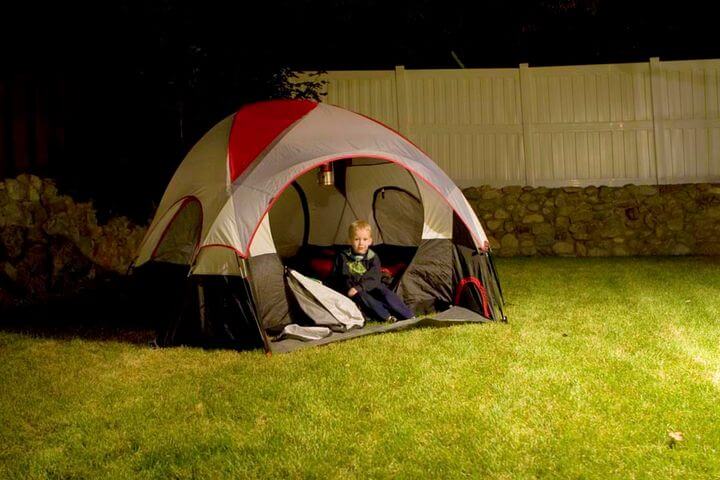
Ready to give it a whirl? Know that every little thing will take FOR-EH-VER, and that meltdowns still happen (as does DIRT). But so do stars and s’mores and big smiles and snuggles.
OK, parents — time to gear up, family camping style.
Major Categories
- Get a Family Tent That Fits
- Gear Up for Bedtime
- Gear up for Mealtime
- Light Your Path
- Layer Up
- Important Odds & Ends
1. Get a Family Tent That Fits
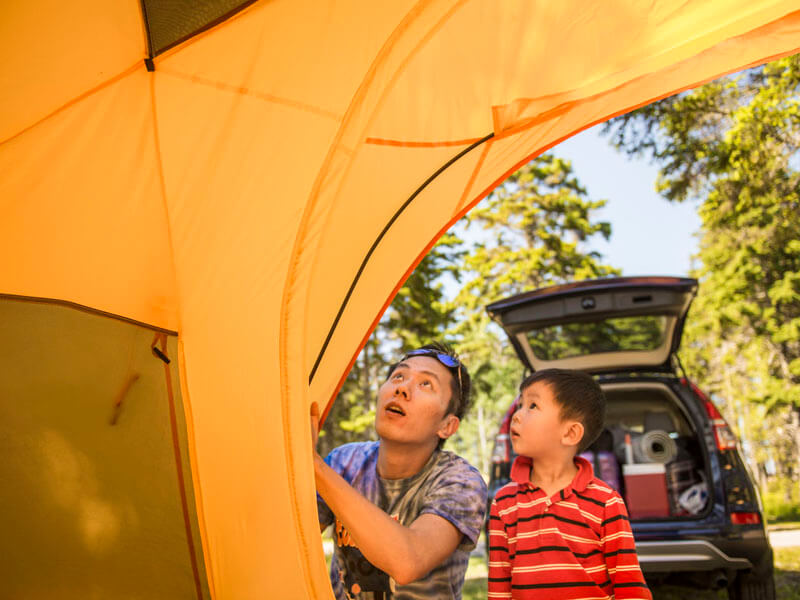
Obviously, first things first, you’re going to need a tent. We recommend up-sizing, as most “4-person” tents are really best for 2, and most “6-person” tents are realistically comfortable for 4 (even kids). The “number” simply represents how many bodies can be crammed in there like sardines. Yes, a family camping tent is one place where bigger really is better (unless you are backpacking). You’ll appreciate the extra breathing room.
Here are your best bets:
Coleman Cabin Tent with Instant Set-Up (6-person) ~$167 — Editor’s Choice
You can’t go wrong with this tent — it’s insanely easy to set up, breathable, and is actually pretty affordable in the tent camp (get it?!).
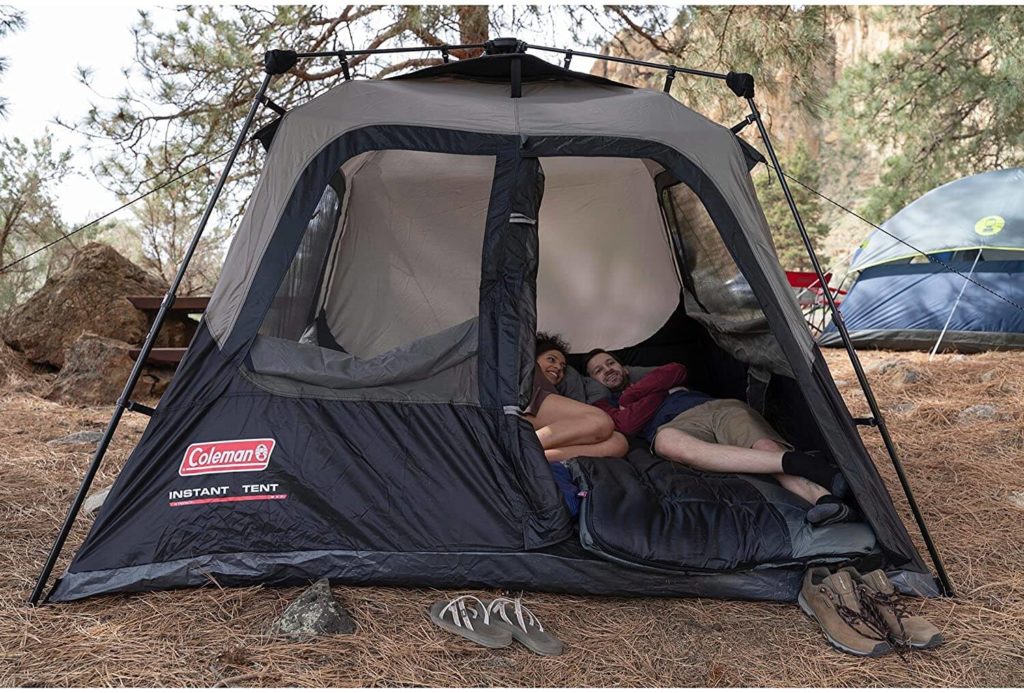

You can also upgrade to the 10-person version (~$379, sheesh), which is roomier and comes fully-equipped with a nice little curtain/divider for separate rooms. Or, you may want to consider the dark room technology canopy (~$144), which blocks light (a nice feature for naptime and summer nights/early AMs). Both of these spin-offs are awesome for kids!
*Note — The Coleman cabin tent design is “weatherproof,” and it comes equipped with an “integrated rainfly,” but we 100% recommend getting an actual rainfly accessory to defend against the elements, as the “built-in” version is, well, chincy. There’s nothing worse than a wet tent — and though this really is a great one, it’s prone to leaking without a dedicated rainfly.
Ozark Trail 8-Person Cabin Tent ~ $169 – Economy Pick
The Ozark 8-Person Cabinet Tent from Walmart is a spacious and versatile camping solution perfect for family trips. Its generous size comfortably accommodates up to eight people, with ample headroom and multiple storage pockets for gear.

The tent features a cabin-style design, providing a home-like feel with large windows for ventilation and panoramic views. Setup is relatively straightforward, thanks to color-coded poles and clear instructions. However, some users have noted that the rainfly could provide better coverage during heavy rain. Overall, this tent offers excellent value for its price, combining comfort and functionality for enjoyable family camping experiences.
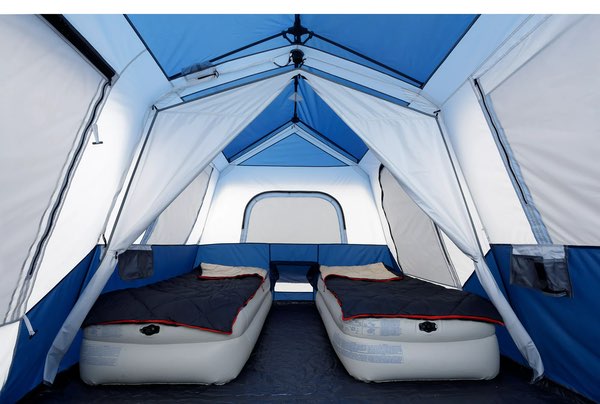

Screen Houses and Shelters
Although it’s not strictly necessary, a screen shelter “house” can also be a very welcome addition to a family campsite. Well worth it on its own, it’s especially nice to have a dedicated bug-free, shaded space when you’re camping with kids (snacks/meals, diaper changes, getting-into-pajamas, playtime, etc.). Think of it as a portable screened-in porch.
The LL Bean Woodlands Screen House (~$449) is a classic can’t-go-wrong pick. For a more wallet-friendly option, the Coleman Skylodge (~$159) will do the trick, although it’s more prone to the elements (i.e, it’s more flimsy… but it still works well enough for leisure campers).
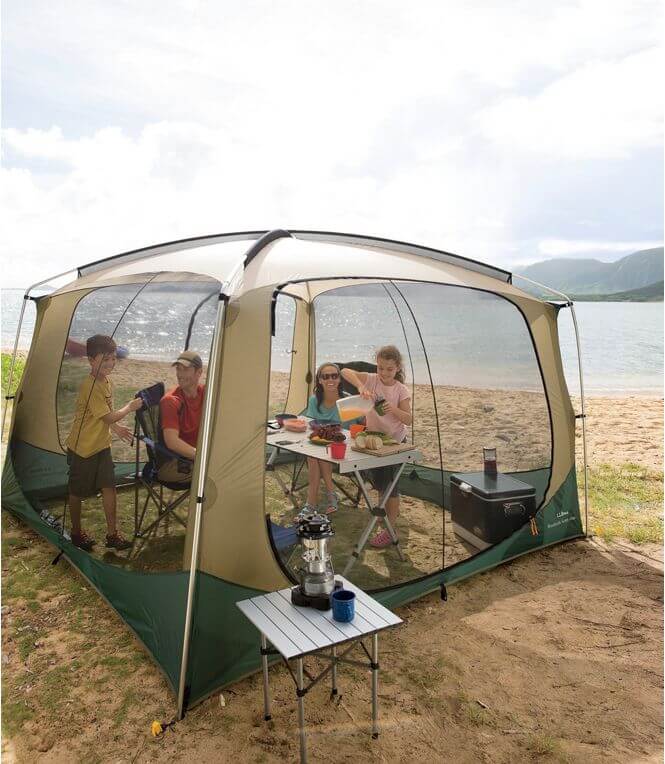

2. Gear Up for Bedtime
When camping (or traveling, really) with a child, SLEEP is always at the forefront of my mind. The best advice we have: do what you can to keep some continuity and familiarity, but know that things will probably pan out a little bit differently. There’s no getting around the fact that sleeping in a tent is different than sleeping at home, and that’s okay!
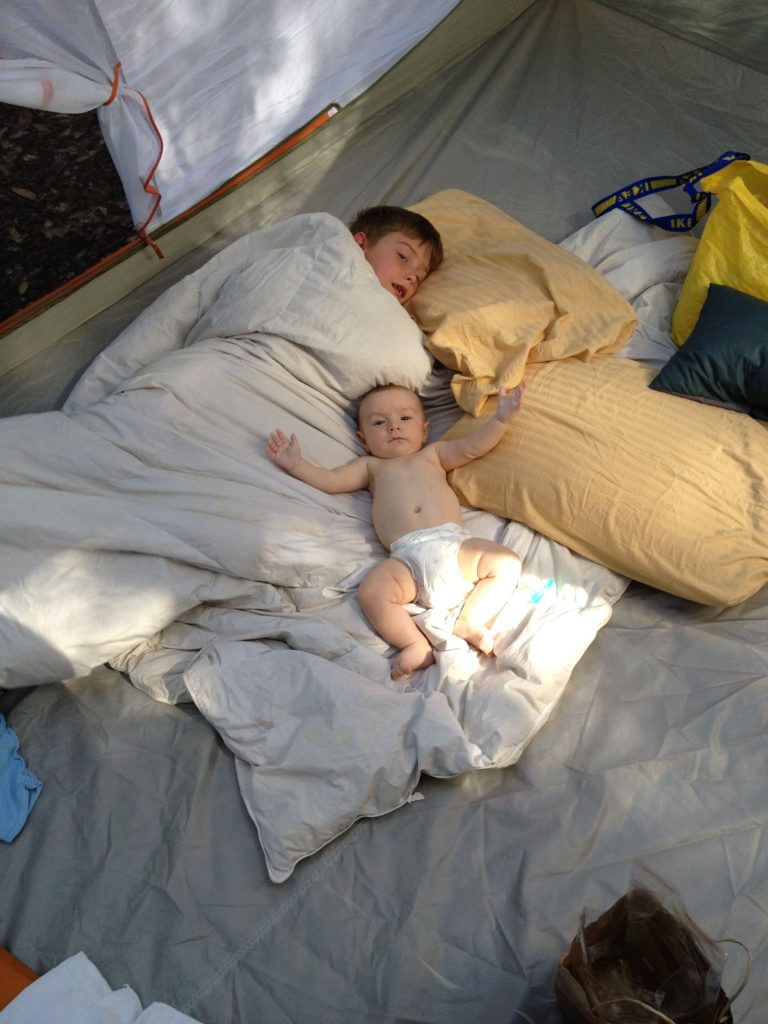
My kids do best overall when we stick to our regular routine as much as possible (and young children broadly thrive when they have a sense of predictability). Naptime is a bit shorter, but it still happens; bedtime is a bit later, though we follow the rhythm that we have at home (complete with pacis, lovey, and whatnot). Oh! And we also use portable/rechargeable white noise machine, which I think is helpful.
Here’s what to pack to make sleep happen while you’re family camping:
Kid-Size Sleeping Bags
Kelty Kids Sleeping Bag ~$54 — Best “Mummy” Sleeping Bag for Kids
Mummy-style sleeping bags (with hoods) are great for littles who don’t yet understand how to snuggle up in a sleeping bag on their own. Kids LOVE them, and this version from Kelty keeps kids safe and warm even in temps as low as 30 degrees (may be too hot for warm nights).
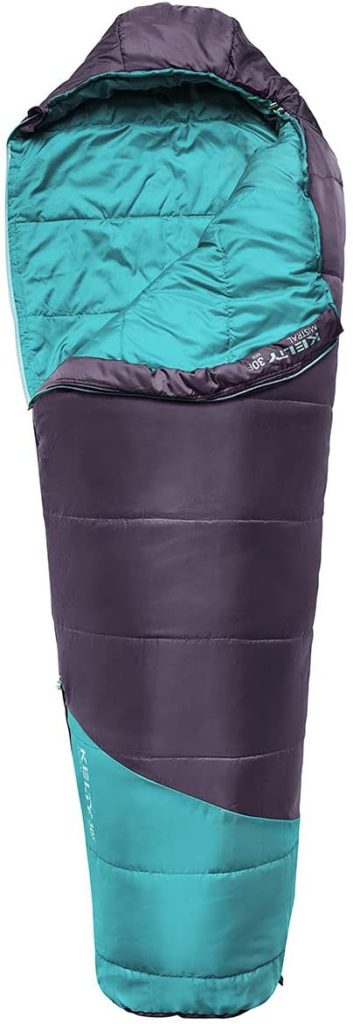

This cozy bag^^ is super soft and the length is adjustable. (Note — if you’re looking for a more economical pick, Columbia makes a similar kids mummy bag that sometimes goes on sale… Coleman used to offer one — and you can still occasionally find it some places — but it’s mostly out of stock these days.)
LL Bean Flannel-Lined Kids Sleeping Bag (40 degrees) ~$89 — Best Block Sleeping Bag for Kids
The LL Bean kids sleeping bag is a classic pick suitable for temps down to 40 degrees. (Now we’re talkin’.) You can’t go wrong with this one.
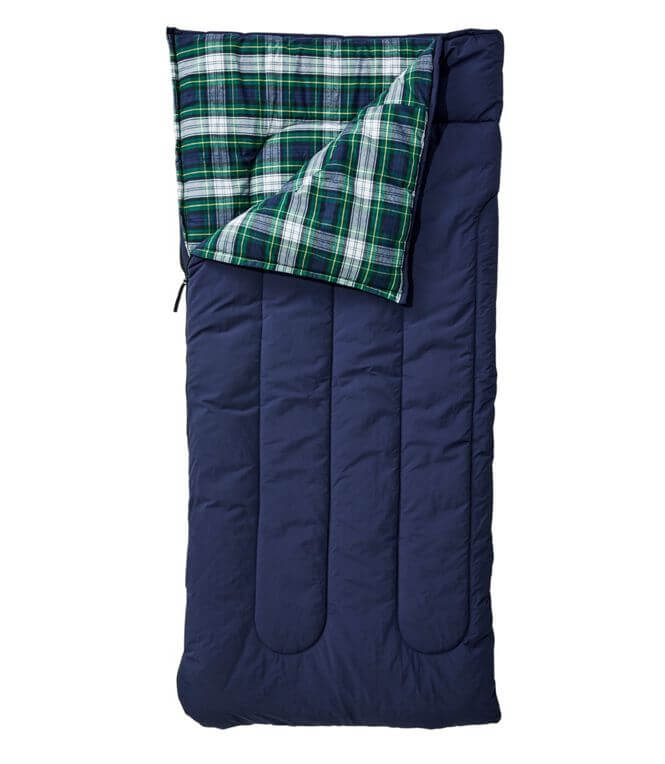

For Babes
If you’re planning an adventure with a little one who’s still too young for a sleeping bag or blanket (in cool or cold weather), a warm bunting will do the trick.
Sleep Nest Travel ~$42
For temps down to 55-65 degrees F
The Sleep Nest Travel from Baby DeeDee is a functional — and economical — choice for a baby sleeping bag. This one comes with removable sleeves and a two-way zipper so it can be worn with a five-point harness (i.e., in a stroller).


Morrison Outdoors Kids’ Sleeping Bag ~$159
For temps down to 20 degrees F 🥶
(~$159 for the baby/toddler bag and $199 for the 4-6 YO version)
Another other very cool (though less versatile) option is the Morrison Outdoors Kids’ Sleeping Bag — it’s like a sleeping bag and a snowsuit had a baby. Definitely this is a top choice is you’re anticipating cold nights.



Patagonia Hi-Loft Down Sweater Bunting ~$169
Not rated for temps (b/c technically it’s a jacket), but has 700 down-fill-power.
Many seasoned family campers like the Patagonia down bunting, which is super warm but still light and breathable. *One thing to note with the Patagonia suit, though, is that it has a hood — which always made me squeamish WTR to bed time… * Note: runs huge (long).


*If your child sleeps in a bed/toddler bed, proceed onward… if you have a baby/toddler in a bassinet or crib, skip ahead to baby sleeping options.
Sleeping Pads for Children
Next up, a kid-friendly sleeping pad for slightly older kids: let us preface this section by saying do not skimp on a sleeping surface! Chances are that if you’re the type who’s interested in taking your little kiddo camping, you’re already a seasoned camper and know that sleeping directly on the ground is a no-go, but just in case we’ve hooked any newbies: don’t sleep in your bag directly on the ground. I don’t care what the temperature is, you’ll be cold, or uncomfortable, or both.
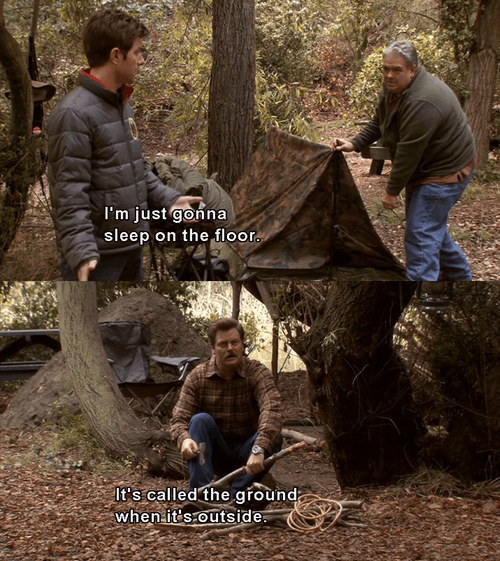
You could opt for a classic inflatable camp sleeping pad, but kids easily fall off those suckers. Think of it like trying to sleep on a slip ‘n slide.
Plus, some kids putz around with the inflation valve, which can result in a) them constantly waking you up to fix the pad, or b) them sleeping directly on the ground… either of which would be enough to drive you batty, which we don’t want. The fewer “things that can pop” the better…
Thus, might we suggest some alternatives:
Regalo My Cot Portable Toddler Bed ~$25 — Economy Pick
Toddlers and preschoolers love these insanely-popular travel beds, and they’re perfect for camping — they keep kids off the cold ground without any fuss.
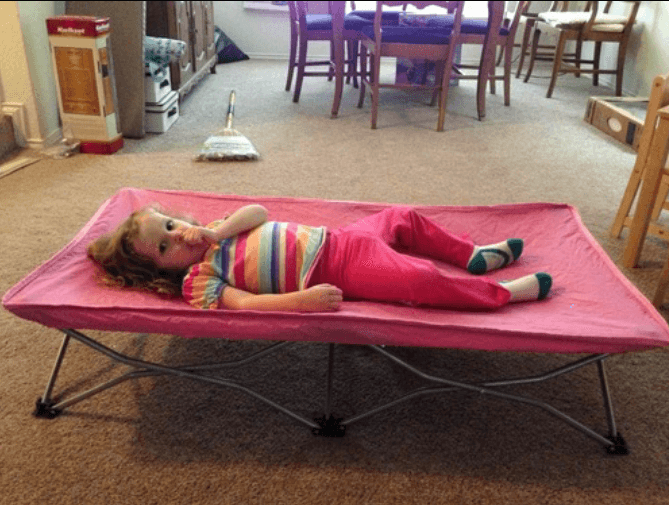
These raised cots (suitable for kids up to 75 pounds) fold up nice and easy, like a canvas camp chair (the soccer-mom kind), and are frankly nice to have around for general car travel (hotel rooms, your sister’s house, etc.), sleepovers, house guests, and the like. It comes with a fitted sheet (and apparently people use them as dog beds, too…)
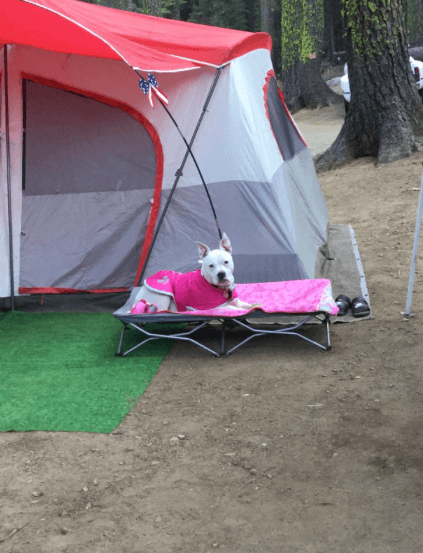

Therm-a-Rest Z Lite Foam Mattress ~$47-$57 — Editor’s Choice
This tried and true foam mattress folds/unfolds super quickly (like an accordion), is incredibly comfortable, equally durable and has a textured/rippled surface that helps kids stay in place while they’re asleep. Plus, since it’s not inflatable, you don’t need to worry about the air level. Downside: it takes up a little more space when packed.
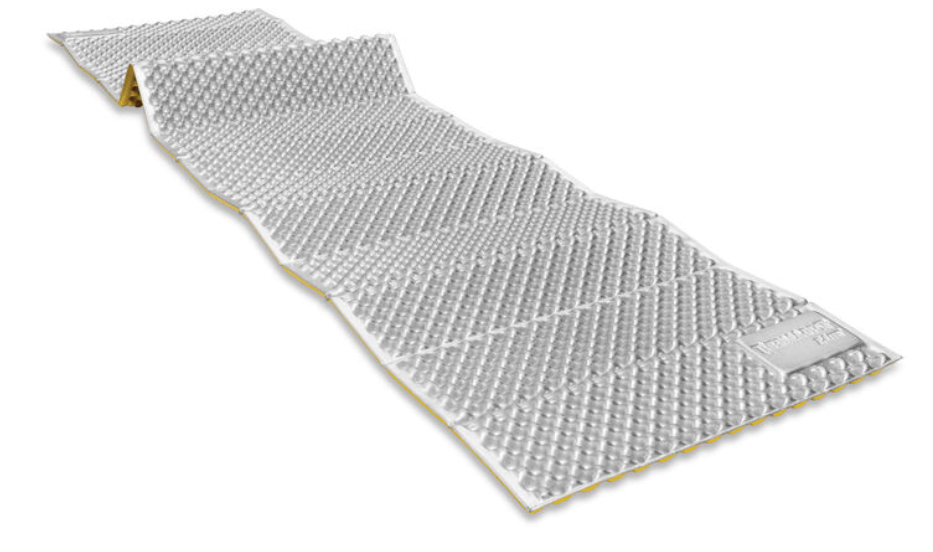
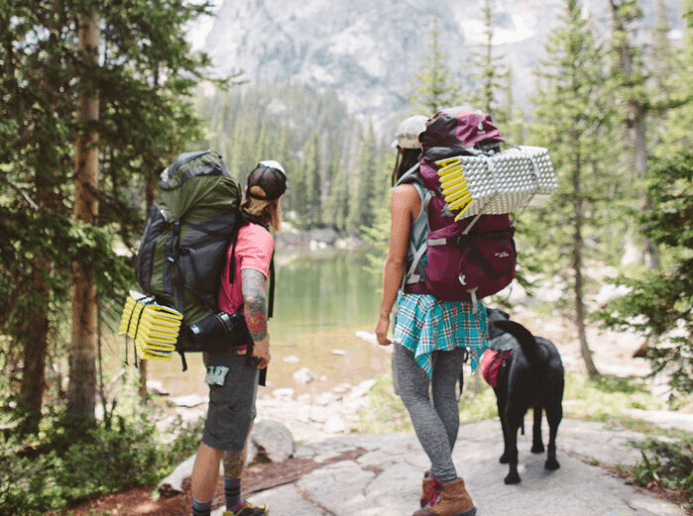

Baby Sleeping Spots
If you have a baby/toddler who is still in a bassinet or a crib, any of our favorite travel cribs (at all different price-points) would be fine for camping trips. One reader also suggested the KidCo Peapod, which is genius — it’s like a tent for inside the tent! — but it’s $$$ (~$99) and tough to find anymore.
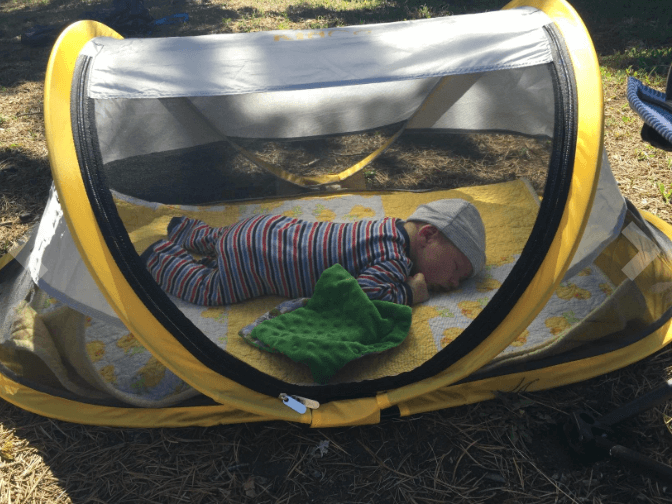
And of course, a classic play yard (aka playpen/Pack N Play) would totally fit the bill — in fact… all things considered, we might recommend a play yard, since it also gives you somewhere to put your kiddo to play/hang out, on a surface that isn’t… the ground. Our budget pick for a play yard is the Graco Pack ‘n Play, and our upgrade pick is the 4moms breeze.
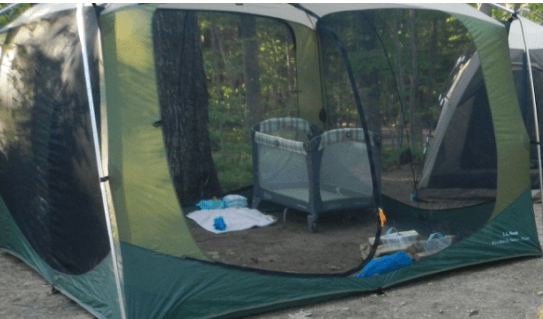
Sleep Soundly — Travel Sound Machines
Lastly, in line with the goal of keeping things as familiar as possible for The Bedtime Routine, you may want to think about bringing along a travel sound machine (or, there’s an app for that). If your child sleeps with a lovey or special blanket, don’t forget it!
3. Gear up for Mealtime
Camping is about spending time in nature, appreciating the great outdoors, etc., etc., yes, yes — but camping with kids is also about… food.
Yes — family camping revolves around the picnic table. Literally.
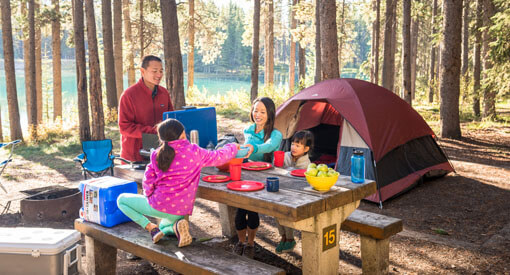
Translation: your kiddos may spend precisely 94% of your camping experience eating. So plan ahead and prep as much as you can. Bring tons of EASY snacks (we love fruit, cheese, and those applesauce pouches that kids everywhere are obsessed with) and do as much meal prep as possible in advance. Trust me, it’s waaaay easier to dole out pre-made PB&Js or heat up frozen meatballs on the camp stove than make them on the spot from scratch.
That said, camp cooking is part of the experience! We suggest trying something quick and simple to start (eggs in the morning, grilled cheese for dinner, beans/chili, etc.). A stove will be the centerpiece of your new makeshift camp kitchen, lol. We love this one in particular:
Coleman Camping Stove ~$52
This is the quintessential camp stove. With 2 burners and a compact fold, this stove is a must for camping families. Bring extra propane so you don’t run out.
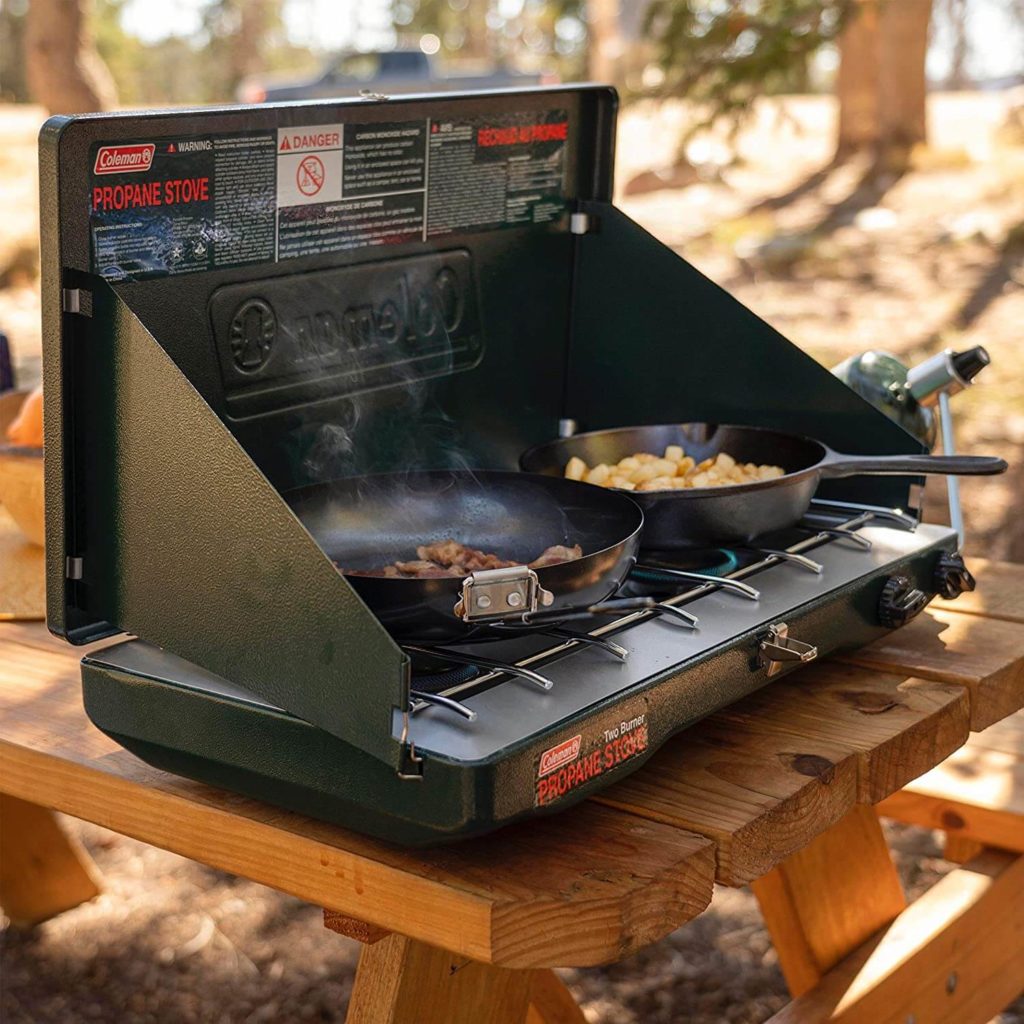

You’re going to need somewhere to store all of your food, drinks and ice:
Coleman 316 Series Cooler ~$109 — Economy Pick
This affordable cooler has a loyal fan base and will serve you well. It’s great for weekend camping trips, as it works wonderfully for a couple of days before “The Melt” will hit you (usually around Day 2). Note that you have to really push the seal to close it and yank it to open it up, which is actually ideal when you have little children around… built-in childproofing!
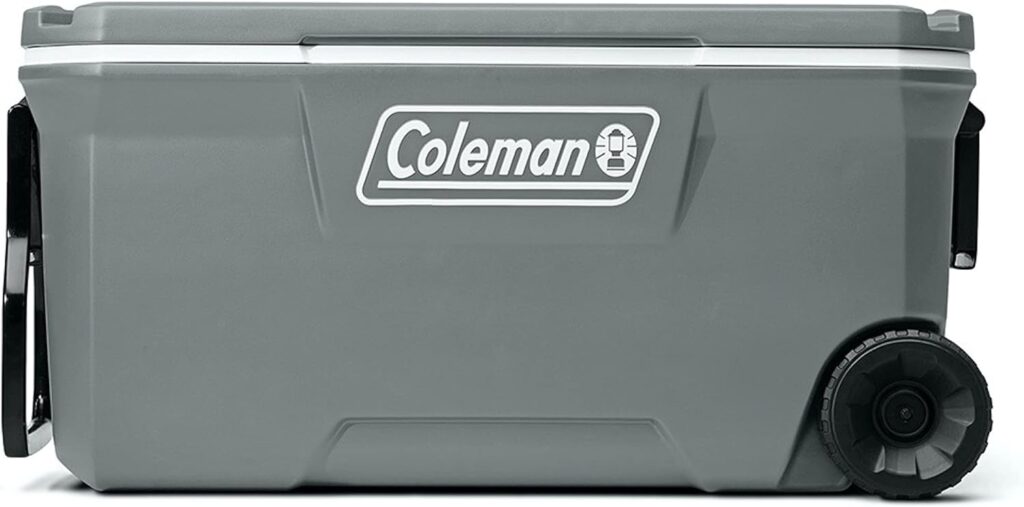

(Psst — we like hard coolers vs. soft coolers for car camping with kids because they help prevent smushing. Plus, extra seating…)
Pro Tip: We prefer to use frozen water bottles (vs. ice) so your cooler doesn’t turn into an aquarium. To do this, just freeze several water bottles (deep freeze is better) several days in advance and voila!
YETI Tundra Haul Cooler ~$450 — Upgrade Pick
Whoa, I know: pricey.
YETIs have a reputation for being the Cadillac of coolers, and they really are top notch. Our YETI has literally kept ice for DAYS on our porch in the summer. Yes, YETI insulation is no joke. Plus, these things are literally indestructible — they’re like little ice tanks. Since they are heavy as sh*t when full, we recommend this wheeled version so you can tow it around easily at your campsite. It’s an investment, but if you spend a lot of time outdoors, this cooler is an MVP that should last a lifetime.
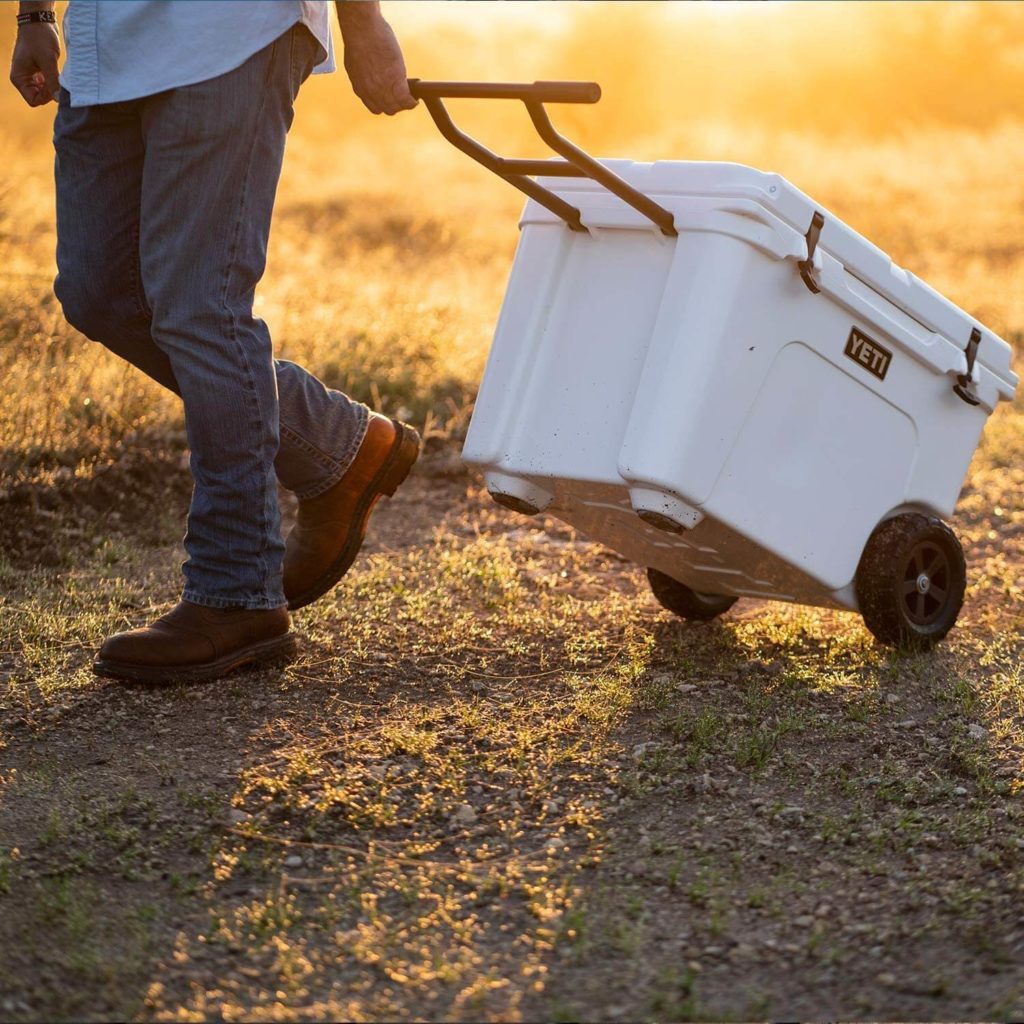

If you like the idea of a YETI but not the price tag, RTIC’s block cooler is similar in design and quality, but often retails for ~$100 less. Definitely worth checking out.
For actual mealtime, there are a ton of kid-specific travel items that will make your weekend much more enjoyable by simply streamlining things. We suggest:
- A travel high chair: the Summer Infant Pop and Sit Portable Booster (~$34) is perfect for camping. Use it on its own or attach it safely to a chair. To get kids up higher, we also love the camp-chair style Ciao Baby Portable High Chair (~$63).
- Kids utensils: the stakes are always low with Take & Toss. At $17, the complete set is economical, lightweight, and easy to clean. (See also: Baby Feeding Gear)
- Your sippy cup of choice (or a water bottle, depending on age)
- Bottle paraphernalia & baby food: *when camping, go for convenience, folks. Always. If you’re formula feeding, splurge on premade formula so you’re not driving yourself crazy with mixing and whatnot at your campsite. If you’ve already started solids, same kind of thing: pack store-bought baby food to keep things easier.
Parents — don’t forget that coffee! Tons of friends love a good french press, and there’s always the good ol’-fashioned percolator, but personally I’m partial to my Aeropress. Yes, coffee while camping is a must-have!
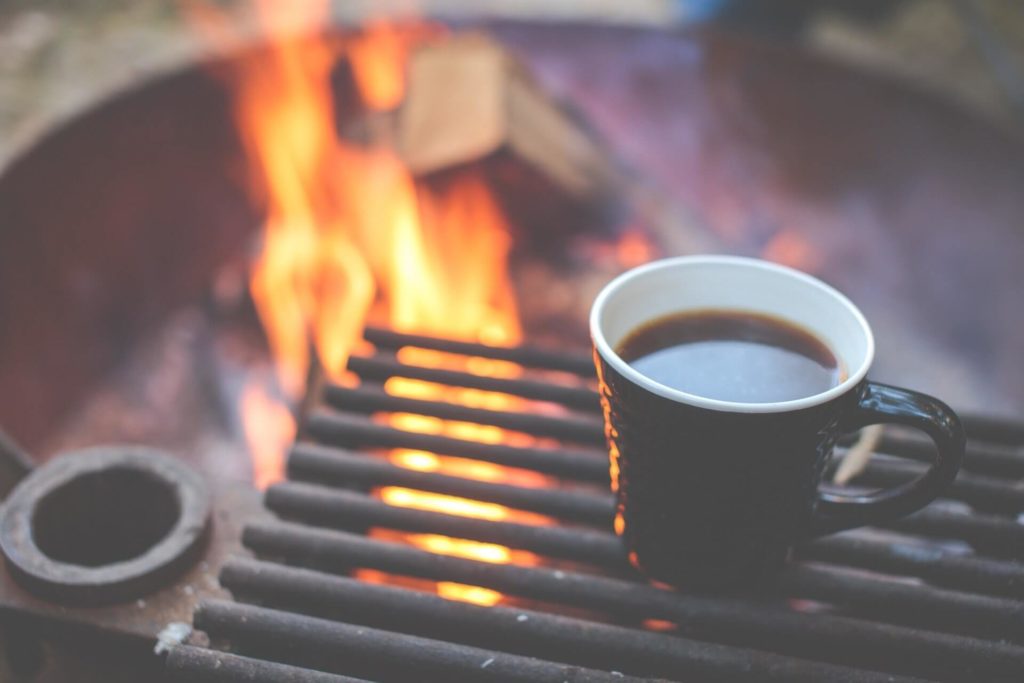
4. Light Your Path
One of my favorite things about camping is just how DARK it gets at night. I love it.
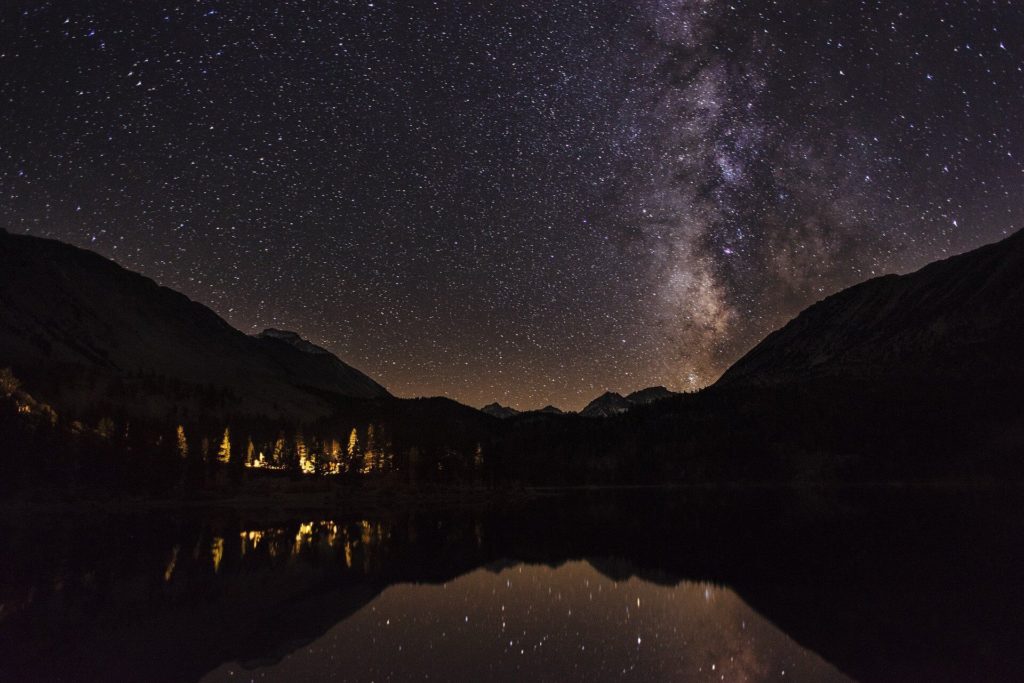
Little kids? They love headlamps. And lanterns. Flashlights. Think about giving your kiddo her very own to love and use for the weekend (note: kids seem to be professional at losing these babies — keep an eye out!).
Make sure you have lights to sufficiently light up your campsite, as well as plenty of individual options for walking around the campground at night, sitting at the table for a meal in the dark, and/or getting to and from the facilities.
Headlamps
There are tons of headlamps out there; and if you’re just out for casual car camping weekends, probably even the cheap ones will suffice. Though, I’ll say that the Black Diamond and the Petzl Actik headlamps are the all-around favorites among serious campers. For toddlers and little children who can have their own, the Black Diamond Wiz Headlamp (~$29) is a solid bet, although it’s not quite as high quality as the company’s adult products.


Lanterns
Get a couple of the Black Diamond Moji Lanterns (they’re awesome) for “real” use, and pick up one of Coleman’s colorful kid-sized lanterns for your kiddo — thank us later. We also love the Firefly! lanterns, which come in various shapes (shark, astronaut and more).
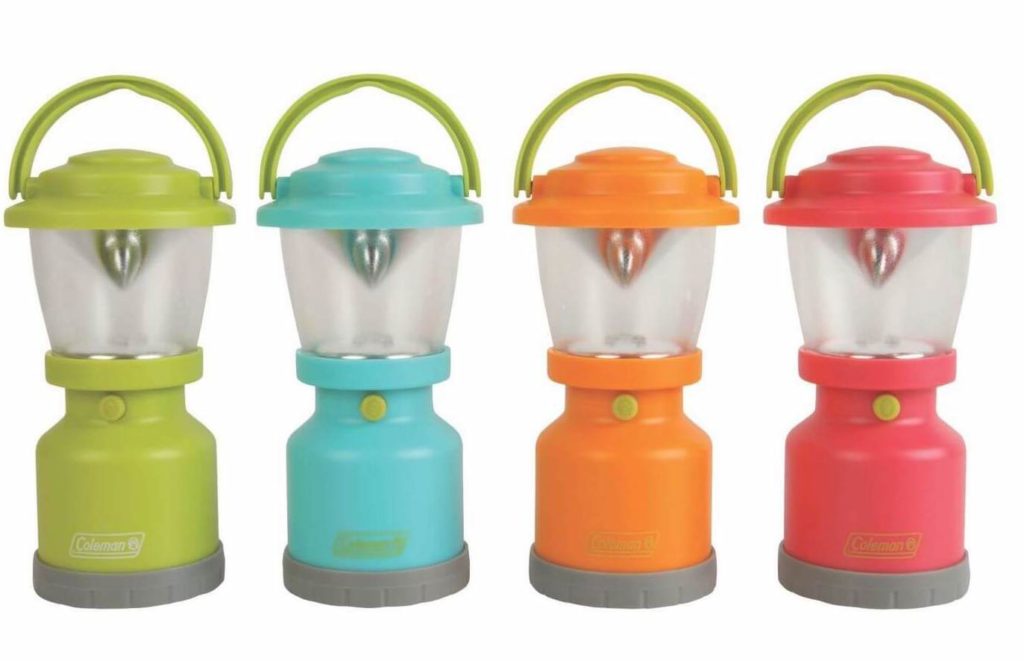

5. Clothes for Camping Weather
If you’re heading out during a heat wave in the middle of July, bring along some items to help keep everyone cool (and sane). *Make sure your kiddo has a sunhat — even if it’s not sunny, it will help protect against ticks and whatnot. The right clothes can set the stage for a great day hike, various outdoor adventures, and a good night’s rest.
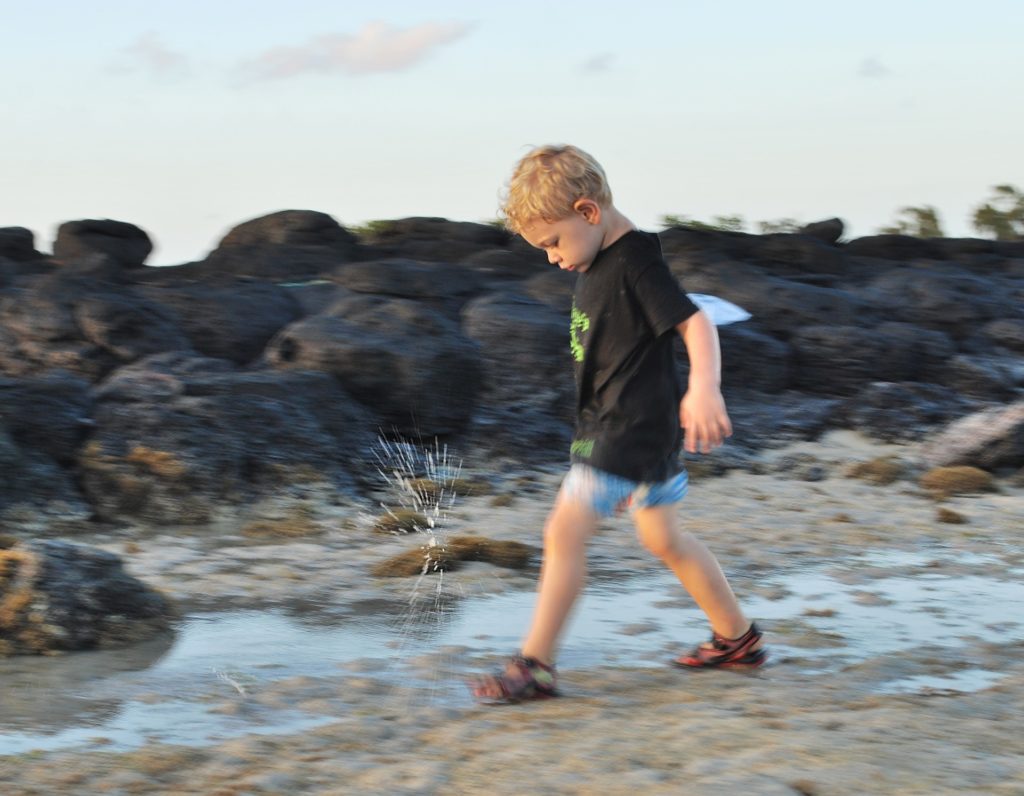
Reader tip: pack a battery-operated fan for especially humid afternoons.
Alternatively, if it’s shoulder season (or tends to run cool, depending on where you are), you’re going to want to make sure you pack plenty of warm clothes and extra layers (see below for some itemized recs). On the west coast, you can count on cool nights. You could also bring along an extra camp blanket for good measure.
- Wee Woolies merino wool pajamas (~$84)
- A winter sleep sack
- Lots of warm layers
- A hat (see our favorite winter hats) and/or mittens for nighttime
6. Don’t Forget: Odds & Ends
Lastly, there are a handful of miscellaneous things to consider packing up:
- A travel diaper changing pad (either a reusable one or disposables), and make sure your diaper bag is well-stocked! Pack some doggie poop bags for dirties.
- *Bug spray: a MUST
- *Sunscreen: YES
- Hand sanitizer, duh
- Water
- Kids shoes that are easy to take on and off (either rain boots or summer slip-ons)
- S’mores supplies! (And Fatwood to light your campfire in a jiffy)
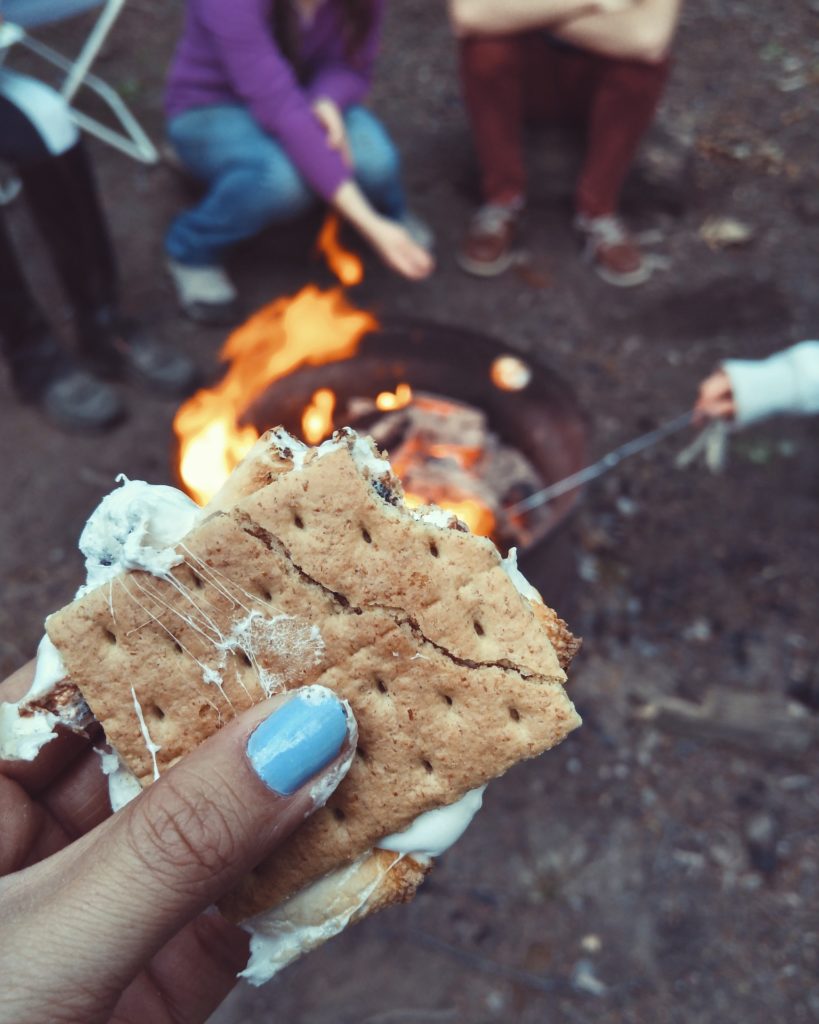
- Your favorite hiking carrier or infant carrier (and an infant carrier cover to keep warm)
- Baby bath (readers prefer the Stokke Flexi Bath Portable Tub) — or, a plain old Rubbermaid tub (pro tip: use it also for easier handwashing at the campsite)
- Bluetooth Speaker – we recommend the Wonderboom, a personal fave that is fully waterproof and very kid-friendly
For those of you planning a trip, remember to keep things low stakes. And don’t beat yourself if it’s not insanely amazing — the first two times we went camping (with our first-born at 6- and 9-months), we reserved a site for the whole weekend and ended up cashing in early. We all slept like sh*t, it was WAY colder than we expected, and in the end, I just wanted to go home, shower, and have a nice night.
And you know what, we did have a nice night!
However difficult (did I say difficult? I meant “different,” I swear) camping with kids is compared to camping adults-only, camping with babies is serious work! But remember: every year, things get easier — little kiddos are “better” campers than toddlers, and toddlers are “better” campers than babies. And as always, the more of a script littles have, the better they do. So camp it up, friends. What else are you doing this summer?
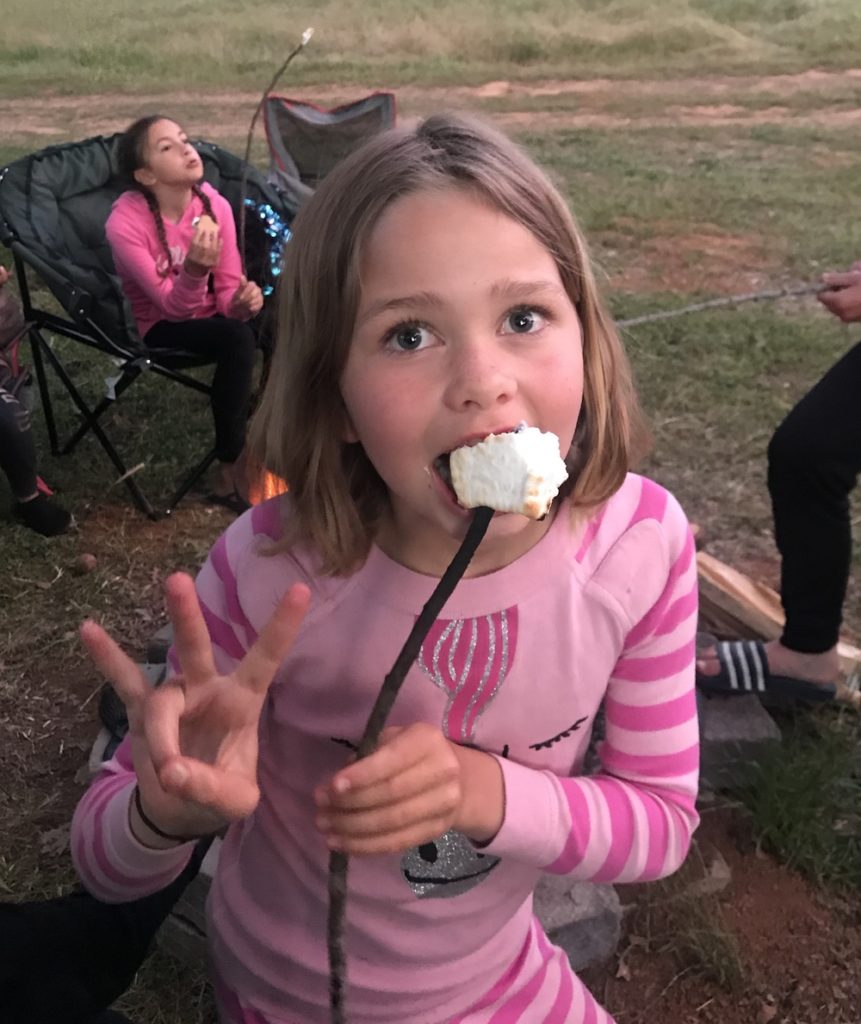
And for those of you who’ve been-there-done-that and rocked a family camping trip, please, please share your tips and tricks in the comments below — we’d all love to hear your suggestions.
Cheers!
Yes, coffee is a must. What is terrible, however, is waiting for water to boil (or getting that fire restarted when you made good use of the adult beverages the night before). Invest in a Jetboil. It takes seconds to boil, uses those fun little fuel canisters, and comes in a variety of styles – even one with the coffee system built in!
For those families camping with infants it’s still possible to follow safe sleep guidelines. We took our first camping trip when our baby was <2 months and have gone multiple times since. Stick to foam pads rather than inflatable. We like the Nemo switchback as an alternative to the z-lite. To keep our blankets / sleeping bags from accidentally getting near baby, we have her sleep inside of a Joovy tent on top of the switchback pad (note the Joovy comes with a pad but it doesn’t provide a high enough R value for sleeping in cold weather). Since the hood of a bunting doesn’t meet safe sleep recommendations, we used fleece PJs, a baby dee dee winter sleep sack (the quilted one is TOG 3.5 and has sleeves), and then a halo fleece swaddle over the top. Our little peanut slept through the night for the first time ever in sub-freezing temperatures with this set-up! And for family tents, we recommend one that has a mesh interior and exterior fly that reaches ground level on all sides. This prevents the inner walls of the tent from becoming dewy or wet and getting your gear wet. Coleman makes a 6-person tent like this for ~$80 and tarp tent makes a lightweight 4-person for anyone for whom packed space and weight are at a premium.
For any parents at high elevation worried about sun exposure for babies under 6-months who can’t wear sunscreen, we like the coolibar one piece bamboo UPF suit (lots cooler than the swimsuit ones that most brands sell!). We also use a men’s large Columbia PFG shirt as a UPF protectant sun cover on our baby Bjorn cattier. We wish there were a true sun cover solution, but this works great in the interim.
This is so helpful!! We’ve been trying to figure out cold night camping and how to keep a baby warm. Thank you for sharing your tips!
I’ve found activities are really helpful- yes there is novelty to being outdoors, and games to be invented using little imaginations (campfire charades, scavenger hunts), but I have found bringing balance bikes or scooters is a lot of fun (or an inflatable kayak if near water etc). Also a mini- Disney kids tent was a blast (our friends brought this and they loved playing in this during the days). My littles are 18 months and 3.5 and we have been camping multiple times this summer and last and really love it. It’s surprisingly relaxing (kids get really worn out and sleep well the second night usually), and nice to come back to a clean house after a weekend away. Echo preparation is key 🙂
We are big campers. Something we’ve done that is very budget friendly for pads for the littles, is take those puzzle shaped floor mats you might have for babies learning to crawl or walk, and use those as pads for the kids. 2 or 3 put together makes a great pad. Kids are light, so they don’t need as much padding as adults.
For cold nights and babies, we just layer. Depending on how cold (and our kids have done well with temps as low as 30 degrees overnight) it is you can start with a short or long sleeve onesie (or both), pants if necessary, socks, then a fleece pair of pajamas, and then a fleece sleep sack. We use a sleep sack for even the 2.5 year old because she wiggles out of her sleeping bag. I am currently in the process of making a bigger one for her.
We actually have two of the KidCo Peapod baby tents that we use for our 2.5 year old and our 1 year old. No worries about the littlest ones climbing around in the tent in the middle of the night, or finding an unsafe place to sleep. We still put a pad underneath it, because it doesn’t come with much of a pad. They do take up a footprint in the tent, though.
My favorite prep tip is to do as much meal prep at home as possible. If you’re having a meal with sliced onions and peppers, slice them at gone. Cut up chicken at home instead of at camp. It just makes the process at camp much more enjoyable.
Bring glow sticks! They help with tracking littles in the dark and marking the boundaries of your campsite. The red glow sticks make for an excellent night light in the tent.
We’ve started an annual tradition of camping with my SIL and her family over Memorial Day weekend, and it’s been really fun, especially because the cousins get playtime together. Bring a couple games for the campsite and warmer clothes than you think you need. My spouse and I upgraded to a double sleeping bag with an air mattress so that I can sleep better (although I still don’t sleep great). I echo that the first camping trip is intimidating, but it gets easier with practice and the kids love spending time outside. But be prepared to be flexible — last time, it rained all morning on our last day, so we just packed up quickly and grabbed McDonald’s for breakfast.